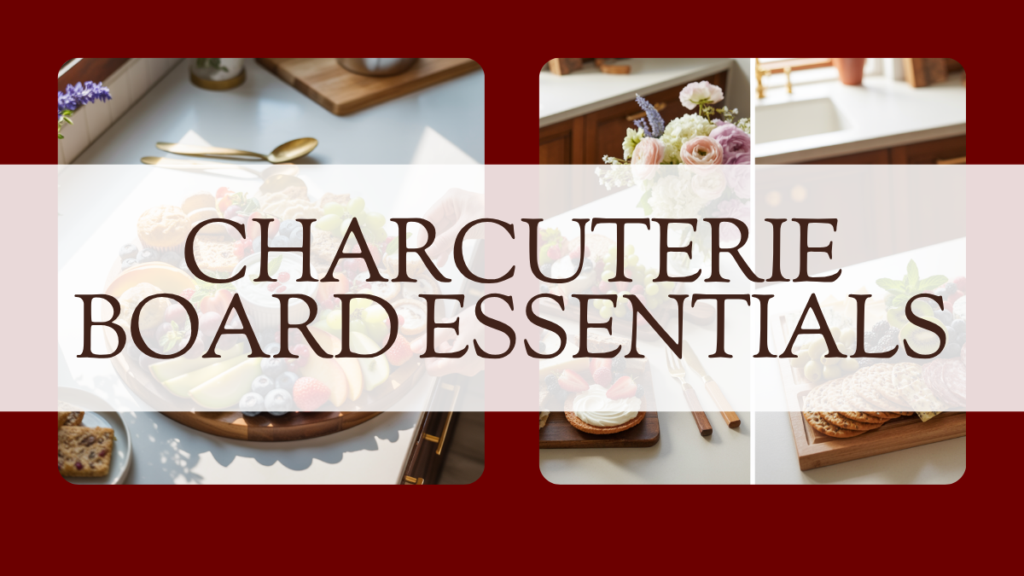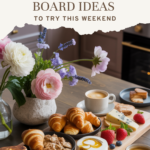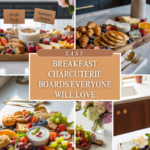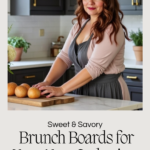Transform your morning meal into a delightful experience with a breakfast charcuterie board. This trendy approach to the first meal of the day offers endless customization possibilities while creating a beautiful centerpiece for your table. Whether you’re hosting weekend guests, planning a special family breakfast, or simply want to elevate your morning routine, these breakfast grazing boards combine convenience with creativity for a memorable start to any day.
A beautiful breakfast charcuterie board brings together sweet and savory morning favorites
What Are Breakfast Charcuterie Boards?
While traditional charcuterie boards focus on cured meats and cheeses, breakfast charcuterie boards reimagine the concept with morning-friendly ingredients. These versatile grazing boards combine sweet and savory breakfast items in an aesthetically pleasing arrangement that invites everyone to customize their perfect breakfast bite.
Unlike a standard breakfast where everyone eats the same thing, these boards allow each person to create their own unique combinations. They’re perfect for accommodating different preferences and dietary needs while creating a communal dining experience that encourages conversation and connection.
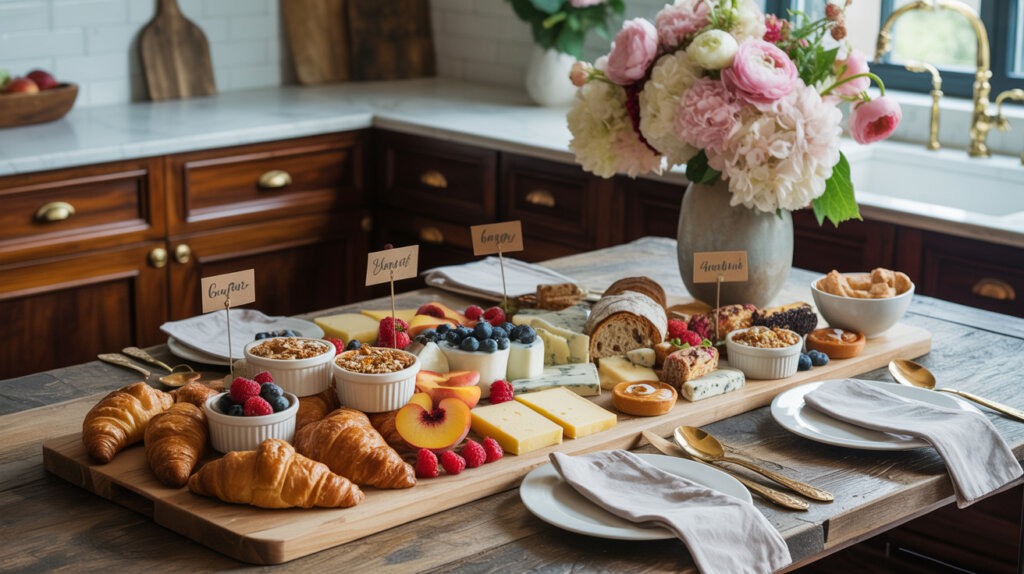
4 Core Components of a Breakfast Charcuterie Board
Creating a balanced breakfast charcuterie board means including a variety of flavors, textures, and options. Here are the four essential components that will ensure your board has something for everyone:
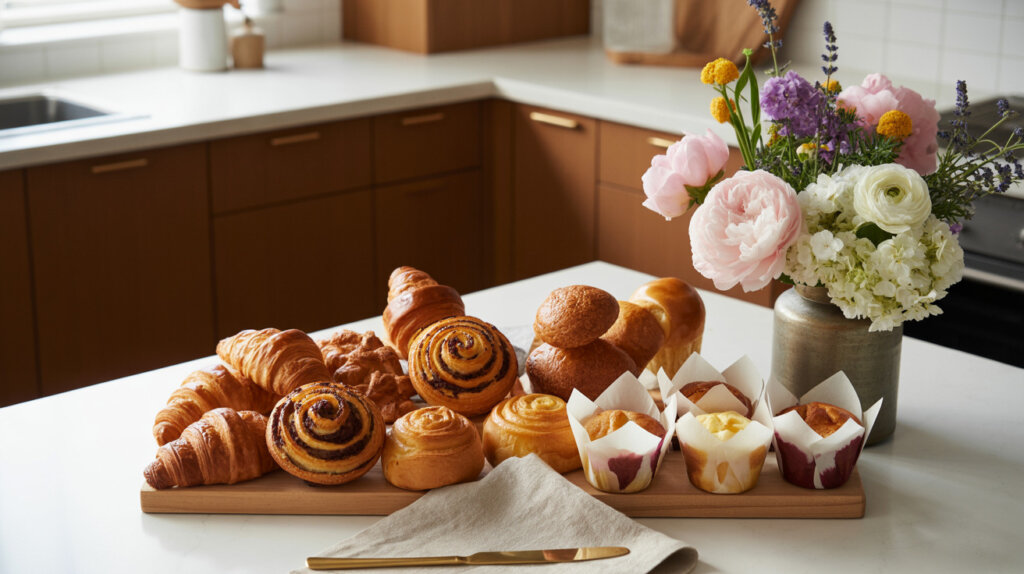
Fresh pastries form the foundation of a breakfast charcuterie board
1. Pastries and Breads
The carbohydrate foundation of your breakfast board provides substance and variety. Include a mix of sweet and savory options:
- Mini croissants (plain and chocolate)
- Small muffins (blueberry, banana, or seasonal flavors)
- Mini pancakes or waffles (can be made ahead and reheated)
- Mini cinnamon rolls or breakfast pastries
- Bagel quarters or mini bagels
- English muffin quarters
Pro tip: Cut larger pastries into smaller, bite-sized pieces to make them easier to grab and to create a more visually appealing arrangement.
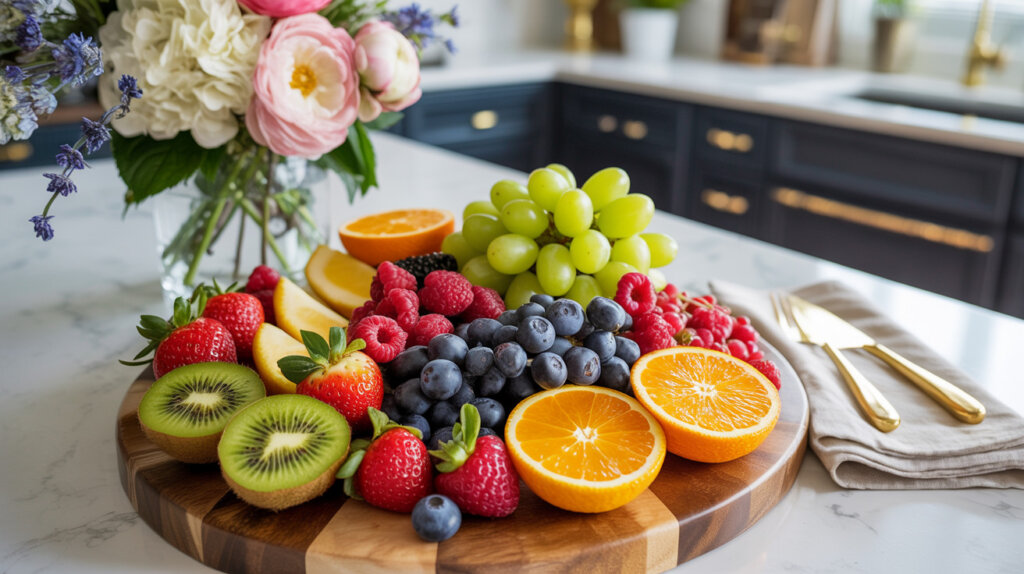
Colorful fresh fruits add natural sweetness and visual appeal
2. Fresh Fruits
Fruits add natural sweetness, vibrant colors, and nutritional value to your breakfast board. Choose fruits that are easy to eat and won’t brown quickly:
- Berries (strawberries, blueberries, raspberries, blackberries)
- Grapes (red, green, or a mix of both)
- Citrus segments (orange, grapefruit, tangerine)
- Sliced kiwi
- Sliced apple or pear (toss in a little lemon juice to prevent browning)
- Banana slices (add just before serving)
Arrange fruits in clusters of similar colors for visual impact, or create rainbow patterns across your board.
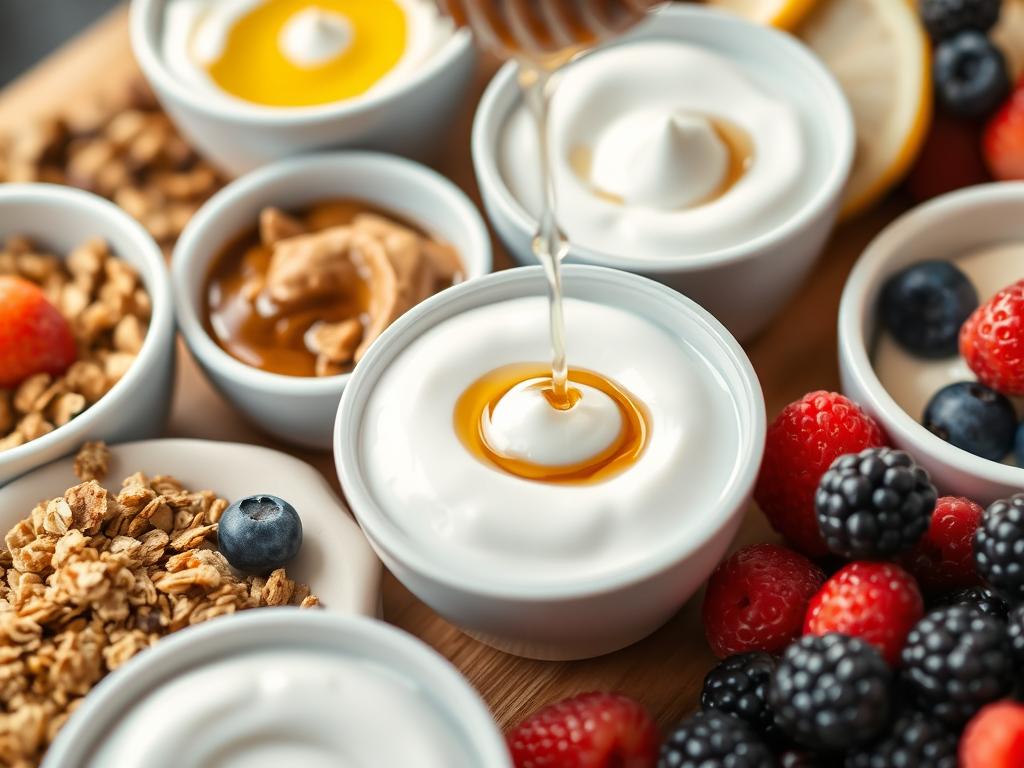
A yogurt station with various toppings offers customizable options
3. Yogurt and Dip Station
Create a customizable yogurt bar within your board using small bowls or ramekins:
- Greek yogurt (plain or vanilla)
- Honey or maple syrup for drizzling
- Nut butters (almond, peanut, or cashew)
- Granola or muesli
- Chia seeds or flaxseeds
- Fruit preserves or compotes
The yogurt station provides a protein-rich option that guests can customize with sweet or crunchy toppings according to their preferences.
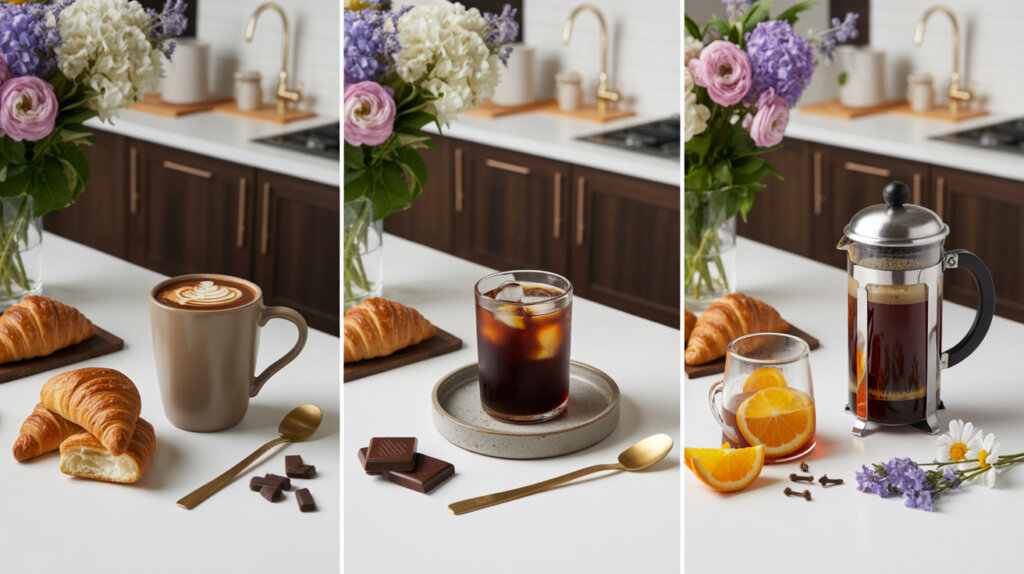
Coffee pairings complete the breakfast experience
4. Coffee Pairings
Complete your breakfast experience with thoughtfully paired coffee options. Consider offering three different brewing styles with complementary board items:
Cappuccino or Latte
The creamy texture pairs beautifully with:
- Buttery croissants
- Cinnamon rolls
- Anything with nuts
Cold Brew
The smooth, less acidic flavor complements:
- Chocolate-based items
- Nut butters
- Banana
French Press or Pour Over
The full-bodied flavor balances well with:
- Citrus fruits
- Berry-based pastries
- Maple-flavored items
Provide small cards identifying each coffee type and its suggested pairings to guide your guests toward delicious combinations they might not have tried before.
Assembly Tips for Your Breakfast Charcuterie Board
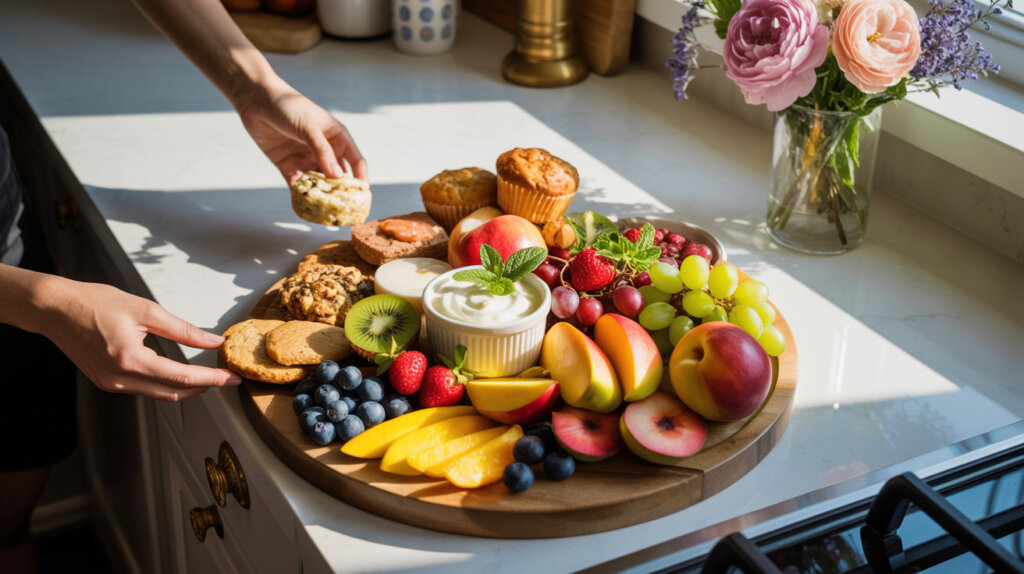
Follow these steps to create a visually stunning breakfast board
Color Arrangement Strategies
The visual appeal of your breakfast charcuterie board is just as important as the flavors. Use these color strategies to create an Instagram-worthy presentation:
- Rainbow effect – Arrange items in a gradual color progression across the board
- Color blocking – Group similar colors together for visual impact
- Contrast – Place complementary colors next to each other (like blueberries next to orange slices)
- Balance – Distribute colors evenly throughout the board rather than concentrating them in one area
Portion Sizes for 2-4 People
For a breakfast board serving 2-4 people, aim for these approximate quantities:
| Component | Quantity for 2-4 People |
| Pastries/Breads | 6-8 mini pastries or bread pieces |
| Fresh Fruits | 2 cups total (½ cup each of 3-4 varieties) |
| Yogurt | 1 cup with 3-4 topping options (2 tbsp each) |
| Spreads/Dips | 3-4 options (¼ cup each) |
Food Safety for Room-Temperature Items
Keep these food safety guidelines in mind when serving your breakfast charcuterie board:
- Don’t leave perishable items (yogurt, cream cheese, etc.) at room temperature for more than 2 hours
- Consider placing your board on a bed of ice if serving outdoors or in warm weather
- Replenish items from refrigerated reserves rather than adding to what’s already on the board
- Use separate serving utensils for each item to prevent cross-contamination
Bonus: Keto Breakfast Charcuterie Board Variation
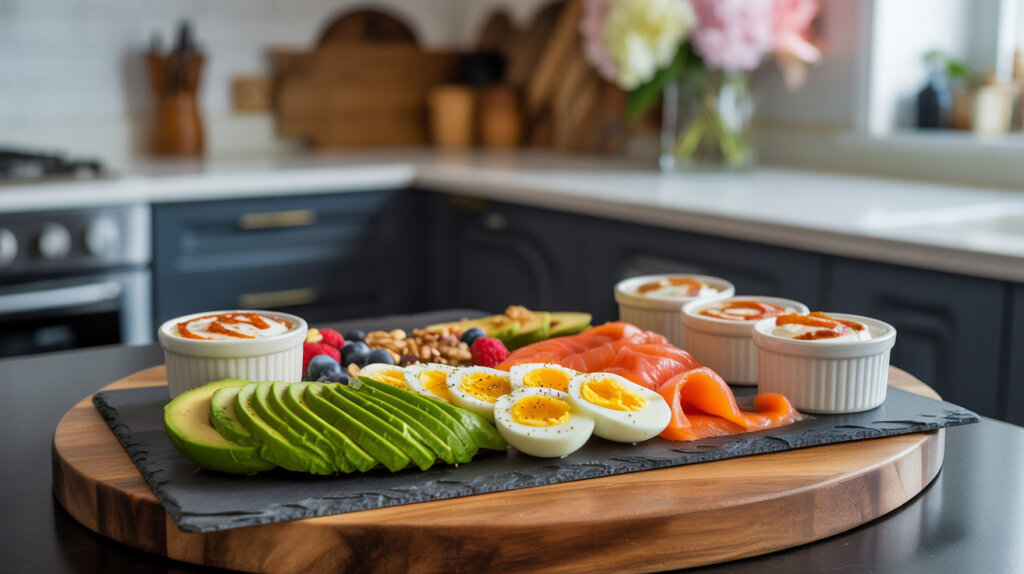
A keto-friendly breakfast board focuses on low-carb, high-protein options
Following a ketogenic diet doesn’t mean missing out on the breakfast charcuterie board trend. This low-carb variation focuses on protein-rich foods and healthy fats while keeping carbohydrates to a minimum.
Low-Carb Substitutes
Replace traditional high-carb pastries and breads with these keto-friendly alternatives:
Instead of Pastries
- Cheese crisps or whisps
- Almond flour crackers
- Cucumber rounds
- Bell pepper slices
- Keto-friendly mini muffins
Instead of High-Sugar Fruits
- Berries (in moderation)
- Avocado slices
- Olives
- Coconut chunks
Protein-Focused Layout Ideas
Center your keto breakfast board around these protein-rich options:
- Smoked salmon – Arrange in loose rolls or flat slices
- Hard-boiled eggs – Halved or quartered
- Bacon – Cooked crispy and broken into pieces
- Breakfast sausage – Sliced into bite-sized pieces
- Cheese variety – Include both soft (brie, cream cheese) and hard options (cheddar, gouda)
- Nuts and seeds – Almonds, walnuts, pecans, pumpkin seeds
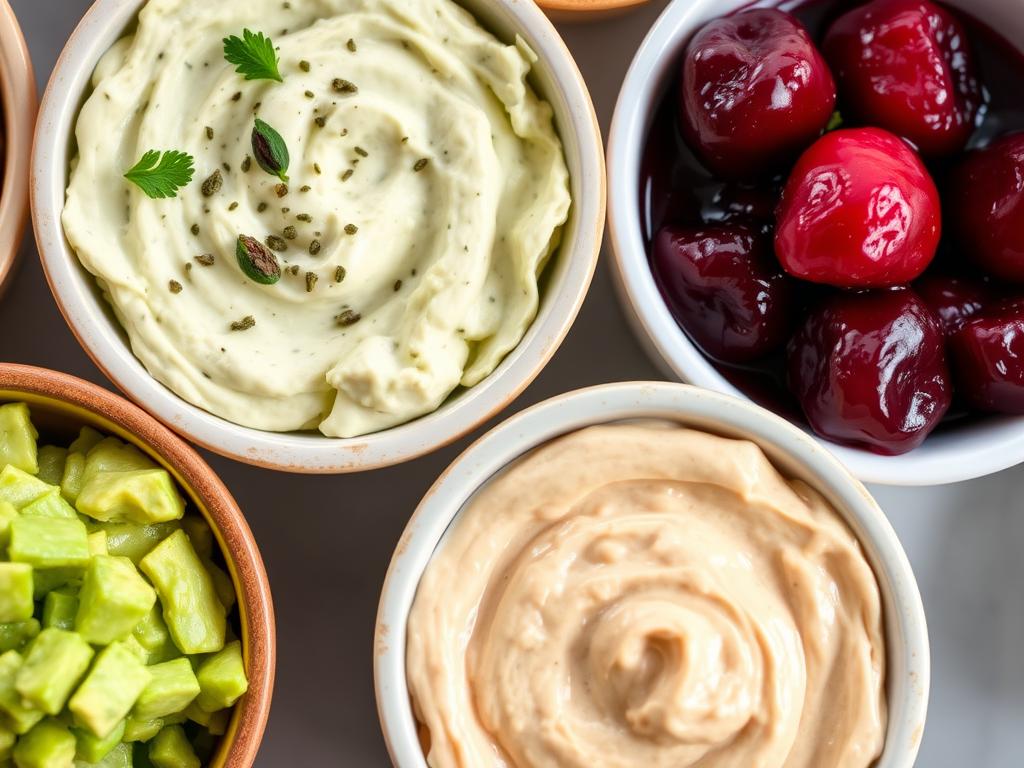
Keto-friendly dips and spreads add flavor without the carbs
Keto-Friendly Dips and Spreads
Include these low-carb options in small bowls:
- Herb-infused cream cheese
- Avocado dip or guacamole
- Sugar-free nut butters
- Low-carb berry compote (made with erythritol or stevia)
GET MY CHARCUTERIE BOARD ESSENTIALS
Create your own charcuterie board supply stash with some of my go to favorites!
From Breakfast to Charcuterie Lunch: Adapting Your Board
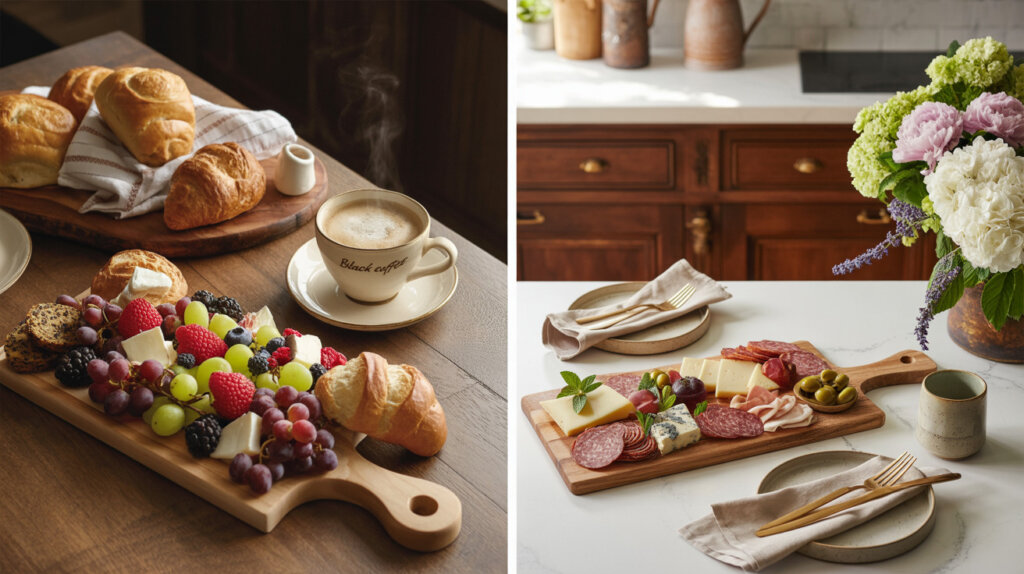
Your morning board can easily transition to lunch with a few simple swaps
The beauty of charcuterie boards is their versatility. With a few simple adjustments, your breakfast board can transition seamlessly into a charcuterie lunch spread that’s perfect for midday grazing.
Morning to Midday Transitions
To transform your breakfast board into a lunch-appropriate spread:
- Replace sweet pastries with savory crackers and bread
- Add more traditional charcuterie meats like prosciutto, salami, and chorizo
- Introduce a wider variety of cheeses, including aged options
- Swap yogurt for hummus or other savory dips
- Include olives, pickles, and marinated vegetables
- Add nuts and dried fruits for texture and flavor variety
This transition allows you to prepare one board base in the morning that can evolve throughout the day, perfect for weekend entertaining or holiday gatherings when people may be eating at different times.
Creating Your Perfect Breakfast Charcuterie Board
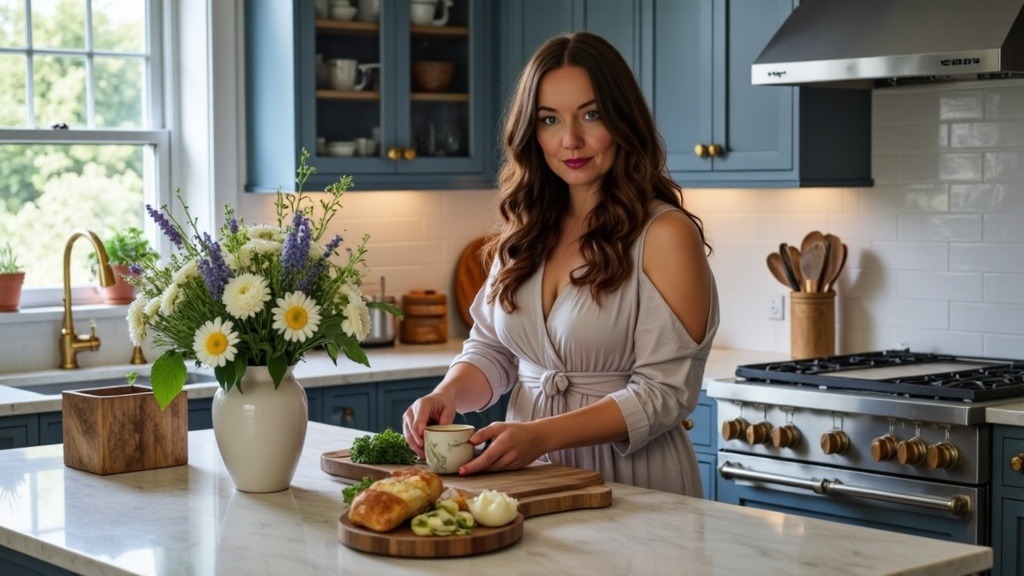
A breakfast charcuterie board brings people together for a shared morning experience
Breakfast charcuterie boards offer a creative, customizable approach to morning meals that can accommodate various tastes and dietary preferences. Whether you’re creating a standard board with pastries and fruits or a keto-friendly version focused on proteins, the key is balance, variety, and thoughtful presentation.
Remember that there are no strict rules—the best breakfast charcuterie boards reflect your personal preferences and those of your guests. Don’t be afraid to experiment with seasonal ingredients, themed boards for holidays, or unexpected flavor combinations.
Pro Tip: Use small ramekins for spreads to keep ingredients separated and visually appealing. This not only improves the board’s appearance but also makes it easier for guests to identify and access different components.
For more grazing board ideas that work throughout the day, consider creating themed boards for different occasions or exploring seasonal variations that showcase the best produce available at different times of the year.
Frequently Asked Questions About Breakfast Charcuterie Boards
How far in advance can I prepare a breakfast charcuterie board?
You can prepare many elements the night before, but assembly is best done within an hour of serving. Prep fruits (except for quick-browning varieties like apples and bananas), portion out yogurt into serving bowls (but don’t add toppings), and arrange non-perishable items on the board. Cover with plastic wrap and refrigerate overnight, then add the remaining items just before serving.
What’s the best board or platter to use?
Wooden boards are traditional and provide a warm, rustic aesthetic, but any large, flat surface works well. Marble slabs offer an elegant look and stay cool (good for dairy items), while slate boards provide a dramatic dark background that makes colorful foods pop. If you don’t have a dedicated board, a large cutting board, baking sheet, or even a clean piece of parchment paper on your counter can work in a pinch.
How do I accommodate dietary restrictions on a breakfast board?
Create distinct sections for different dietary needs and clearly label them. For example, keep gluten-free items in one area, dairy-free in another, and so on. Use different colored serving utensils for each section to prevent cross-contamination. Consider having small cards identifying which items meet specific dietary requirements (GF, DF, V, etc.) to help guests navigate the board easily.
